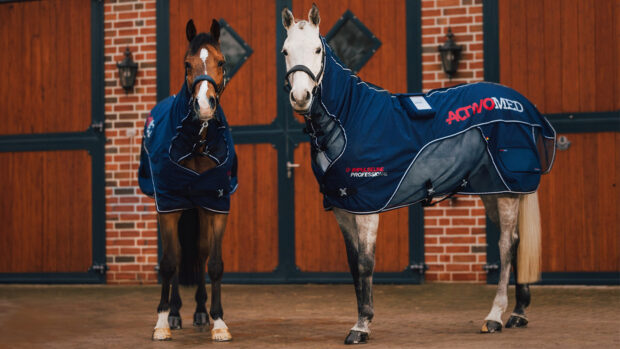Muscular fatigue, cramps and stiffness are the result of a pH imbalance caused by lactic acid.
At its most basic, magnotherapy has something in common with massage, but without the pressure, as it’s said to increase blood flow and assist the removal of toxins and waste products for quick recovery.
Performance can be improved and the chances of injury are dramatically reduced if muscles and joints are properly warmed up before use, and soothing those aching joints and muscles afterwards definitely speeds up the repair process.
“Magnets are a very big thing on the eventing circuit,” says international eventer Lucy Thompson, who runs Equine Sport Therapy along with sports therapist Chris Caden-Parker.
“I’ve used a wide range of them on all my horses. They’re particularly useful for travelling as you’ll find that after a long trip, the horses wearing magnetic rugs definitely come off the box less stiff.”
Connective tissue
The end result of magnetic therapy is to increase the blood circulation.
There’s no doubt that increased blood flow brings healing effects in such instances once the initial inflammation has subsided.
Sally Beves from the Equine Unit at Hartpury College, Glos, investigated the effects of magnetic tendon boots on tendon temperatures.
During her research, Sally used thermography to measure tendon temperatures after the application of Magno-Pulse tendon boots and found that there was no significant increase in tendon temperatures of the magnet-treated limb compared to the control limb after a 12-hour period.
After a 24-hour period, however, there was a significant increase of an average of 2øC of the magnet-treated limb compared to the control limb. A rise of almost 1øC remained in the “magnetised” limb even one hour after the boots had been removed, much longer than the warmth generated by the thermal properties alone of the non-magnetised boot on the control limb.
Bony tissue
Recent studies have proven that those people with fresh or delayed-union fractures do actually benefit from magno-therapy, and results from general public usage suggest that horses with arthritis may be equally as successful.
Research has shown that pulsed electromagnetic fields, as opposed to static magnets, have been successfully used in the treatment of union and non-union fractures and has been observed to healbroken bones in a greatly reduced time in humans
Soft tissue
Muscular stiffness and conditions such as filled legs (from poor circulation, not from inflammation) and windgalls should improve with the use of magnotherapy boots.
Many physiotherapists believe that the magnetic fields (particularly the pulsing fields) can penetrate soft tissue injuries where muscle damage may be too deep or too sore for manual manipulation.
However, others would argue that the static magnets sold for horseowners would never penetrate this far and nor should they in untrained hands.
Horn growth and foot conditions
It has been suggested that the increased circulation that seems to be an effect of magnetic field therapy can help the feet, both in terms of promoting good quality horn growth and easing conditions of the hooves where restricted blood flow is a factor, such as navicular and laminitis.
Event rider Lucy Thompson says she has witnessed some impressive results
“We had three horses that were hard to keep sound and just didn’t respond to the usual feed supplements or hoof dressings,” says Lucy. “One had cracked, brittle feet, one had very slow-growing horn of poor quality and the other had soft, flaky feet. Over a period of about two years, regular use of magnetic bell boots transformed them all.”
Robert Eustace FRCVS of the Laminitis Clinic in Wiltshire is not so impressed, however. “We tried a number of magnetic products some years ago without any success. Horses with laminitis need the correct drugs and good management, not gimmicks. Eighty per cent of cases will get better anyway with good management, then people place the credit with the gimmick!”
Pain relief
Along with the improved waste removal and nutrient-rich blood which is a result of magno-therapy comes drug-free pain relief – very important for athletes of all species who are likely to be tested for illegal drugs.
For horses that are constantly receiving a lot of drugs, magnetic therapy may be used in conjunction with other pain relieving therapies, such as acupuncture, in order to reduce the toxic build up in a horse’s system.
Magnets can be used to target acu-puncture points, so you can benefit from the healing and pain-relieving principles without having to endure the needles, although most therapists continue to use laser for this purpose.
Most experts admit that even where it doesn’t do any good, magnotherapy at least can do very little harm, with the following exceptions.
DO NOT USE MAGNETS:
- In the first 48 hours after injury. The circulation-boosting effects will make inflammation and bleeding worse.
- On an untreated infection.
- On an open wound.
- On an area where liniment has been applied in the last 24 hours.
- While exercising your horse or if your horse has a metal pin or plate implanted in the affected area.
- Before obtaining a proper diagnosis from your vet.
- On a horse diagnosed with cancer.
Read about other alternative therapies:



